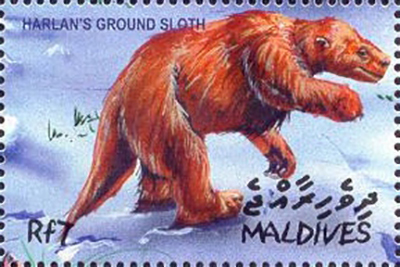Paramylodon harlani Owen, 1840

(Da: it.wikipedia.org)
Phylum: Chordata Haeckel, 1874
Subphylum: Vertebrata Cuvier, 1812
Classe: Mammalia Linnaeus, 1758
Ordine: Pilosa Flower, 1883
Famiglia: Mylodontidae Gill, 1872
Genere: Paramylodon Brown, 1903
Descrizione
Questo grande e pesante animale, strettamente imparentato con gli attuali bradipi, era un erbivoro, e viveva nelle pianure aperte del continente americano fino a circa 10.000 anni fa. Le zampe possenti erano armate di unghioni con i quali il paramilodonte avvicinava a sé le fronde degli alberi e si difendeva dai predatori, come le tigri dai denti a sciabola del genere Smilodon. La corporatura massiccia, già di per sé, costituiva un formidabile deterrente; il pelame, con tutta probabilità, era molto folto e al di sotto era presente una sorta di corazza costituita da piccoli tubercoli. L'andatura di questo animale, lungo circa 3 metri, era molto goffa e lenta. Molti resti di Paramylodon sono stati rinvenuti nei famosi pozzi di bitume di Rancho La Brea, in pieno centro di Los Angeles. Probabilmente i paramilodonti, animali non troppo intelligenti, venivano attirati dalle pozze d'acqua e poi vi rimanevano intrappolati a causa del bitume sottostante, facile preda di carnivori che, a loro volta, rimanevano invischiati nella trappola mortale. Un genere assai simile, esclusivamente sudamericano, è il Glossotherium, con il quale è spesso confuso.
Diffusione
È un mammifero xenartro estinto, vissuto nel Pleistocene. I suoi resti sono stati ritrovati in Nordamerica.
Bibliografia
–Samantha Presslee, Graham J. Slater, François Pujos, Analía M. Forasiepi, Roman Fischer, Kelly Molloy, Meaghan Mackie, Jesper V. Olsen, Alejandro Kramarz, Matías Taglioretti, Fernando Scaglia, Maximiliano Lezcano, José Luis Lanata, John Southon, Robert Feranec, Jonathan Bloch, Adam Hajduk, Fabiana M. Martin, Rodolfo Salas Gismondi, Marcelo Reguero, Christian de Muizon, Alex Greenwood, Brian T. Chait, Kirsty Penkman, Matthew Collins und Ross D. E. MacPhee: Palaeoproteomics resolves sloth relationships. Nature Ecology & Evolution 3, 2019, S. 1121-1130.
–Gaudin, Timothy J. (2004). "Phylogenetic relationships among sloths (Mammalia, Xenarthra, Tardigrada): the craniodental evidence". Zoological Journal of the Linnean Society. 140 (2): 255-305.
–Rincón, Ascanio D.; Solórzano, Andrés; McDonald, H. Gregory; Flores, Mónica Núñez (2017-06-01). "Baraguatherium takumara, Gen. et Sp. Nov., the Earliest Mylodontoid Sloth (Early Miocene) from Northern South America". Journal of Mammalian Evolution. 24 (2): 179-191.
–Brambilla, Luciano; Ibarra, Damián Alberto (2018-11-02). "Archaeomylodon sampedrinensis, gen. et sp. nov., a new mylodontine from the middle Pleistocene of Pampean Region, Argentina". Journal of Vertebrate Paleontology. 38 (6): e1542308.
–Varela, Luciano; Tambusso, P Sebastián; McDonald, H Gregory; Fariña, Richard A (2019-03-01). "Phylogeny, Macroevolutionary Trends and Historical Biogeography of Sloths: Insights From a Bayesian Morphological Clock Analysis". Systematic Biology. 68 (2): 204-218.
–Boscaini, Alberto; Pujos, François; Gaudin, Timothy J. (November 2019). "A reappraisal of the phylogeny of Mylodontidae (Mammalia, Xenarthra) and the divergence of mylodontine and lestodontine sloths". Zoologica Scripta. 48 (6): 691-710.
–McAfee, Robert K. (2009). "Reassessment of the cranial characters of Glossotherium and Paramylodon (Mammalia: Xenarthra: Mylodontidae)". Zoological Journal of the Linnean Society. 155 (4): 885-903.
–Richard Harlan: Description of the jaws, teeth, and clavicle of the Megalonyx laqueatus. The Monthly American journal of geology and natural science 1, 1831, S. 74-76.
–Richard Harlan: Description of the jaws, teeth, and clavicle of the Megalonyx laqueatus. Medical and physical researches, 1835, S. 334-336.
–H. Gregory McDonald: Gravigrade xenarthrans from the early Pleistocene Leisey Shell Pit 1A, Hillsborough County, Florida. Bulletin of the Florida Museum of Natural History 37, 1995, S. 345-373.
–Richard Owen: Fossil Mammalia. In Charles Darwin (Hrsg.): Zoology of the Voyage of H.M.S Beagle, under the command of Captain Fitzroy, during the years 1832 to 1836. Part I. Fossil Mammals. London, 1840, S. 12-111 (S. 63-73).
–Richard Harlan: Notice of two new mammals from Brunswick Cana, Georgia; with observations on the fossil quadrupeds of the United States. The American journal of science and arts 43, 1842, S. 141-144.
–Richard Owen: Description of the skeleton of an extinct gigantic Sloth, Mylodon robustus, Owen, with observations on the osteology, natural affinities, and probable habitats of the Megatherioid quadrupeds in general. London, 1842, S. 1-176.
–Richard Lydekker: Catalogue of the fossil Mammalia in the British Museum of Natural History. Part V. London, 1887, S. 1-345 (S. 106).
–Juan Carlos Fernicola, Sergio F. Vizcaíno und Gerardo De Iuliis: The fossil mammals collected by Charles Darwin in South America during his travels on board the HMS Beagle. Revista de la Asociación Geológica Argentina 64 (1), 2009, S. 147-159.
–Barnum Brown: A new genus of ground sloth from the Pleistocene of Nebraska. Bulletin of the American Museum of Natural History 29, 1903, S. 569-583.
–Glover M. Allen: A new Mylodon. Memoirs of the Museum of Comparative Zoology 40 (7), 1913, S. 319-346.
–Chester Stock: Further observation on the skull structure of the mylodont sloths from Rancho La Brea. University of California Publications, Bulletin of the Department of Geology 10, 1917, S. 165-178.
–Chester Stock: Cenozoic gravigrade edentates of western North America with special reference to the Pleistocene Megalonychinae and Mylodontidae of Rancho La Brea. Carnegie. Institute of Washington 331, 1925, S. 1-206.
–H. Gregory McDonald: Sexual dimorphism in the skull of Harlan's ground sloth. Contribution in Science 510, 2006, S. 1-9.
–Lucas Kraglievich: Cuatro nuevos gravigrados de la fauna Araucana "Chapadmalense". Anales del Museo Nacional de Historia Natural de Buenos Aires 33, 1925, S. 215-235.

|
Data: 21/05/2002
Emissione: Animali preistorici Stato: Maldives Nota: Emesso in un foglietto di 6 v. diversi |
|---|